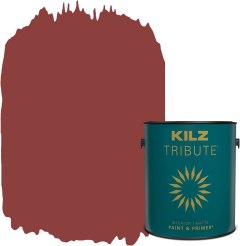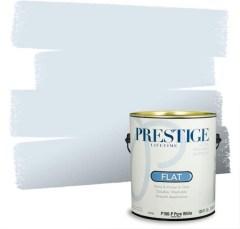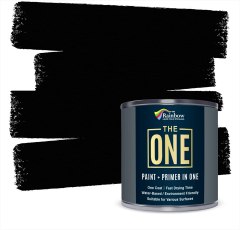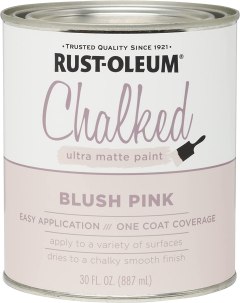BestReviews is reader-supported and may earn an affiliate commission. Details

Our home improvement expert notes that this brand is known for great coverage and stain-hiding.
Product has a matte finish that’s durable and mildew-resistant. Available in a range of warm colors that provide coverage with 1 coat that dries smooth even on textured walls. Adheres well to coated or uncoated wood, drywall, masonry, and cured plaster.
Some complaints that the actual colors don't perfectly match the online swatches.

Our expert's go-to pick for its durable formula and long-lasting sheen at a great price point.
The dual-purpose paint and primer formula makes it easy to apply in multiple parts of the home. Low-odor. Various levels of sheen. Has a good amount of durability and resists stains and scratches fairly well. Fairly easy to apply. The formula is mildew-resistant.
May need multiple coats to cover darker colors.

Rich, flat paint formula that provides a deep matte color; approved by our expert.
Combination paint and primer in an array of blues and grays that are great for bathrooms or bedrooms. Flat paint formula gives this rich pigment and smooth, matte color. Acrylic latex formula allows it to be washed when dried and is low VOC, reducing odor.
Colors may be slightly different than what’s pictured.

Fast-drying option that our expert notes is a thick paint ideal for doors and furniture.
Water-based paint-and-primer combination that covers most surfaces with just 1 coat. Highly pigmented formula comes in a choice of several stylish colors and dries quickly to produce a beautiful finish. Can be used indoors or outdoors.
Although rare, sometimes 2 coats are necessary.

The perfect paint for furniture up-cycles and small home projects.
Paint adheres well to most interior surfaces and dries within 30 minutes. Color can be easily distressed to give a vintage look. The 30-ounce can is ideal for small home projects and touchups. Easy to use with minimal prep.
Some found the clear top coat paint to be cloudy.

We recommend these products based on an intensive research process that's designed to cut through the noise and find the top products in this space. Guided by experts, we spend hours looking into the factors that matter, to bring you these selections.

One of the most effective ways to give the interior of your home a whole new look for a very reasonable price is with a fresh coat of paint. While it can be a bit messy, painting the interior of a room — or several rooms — is a project that even a newbie to DIY can generally accomplish with excellent results. Watching your paintbrush or roller smooth paint across the wall can actually be very enjoyable, which is perhaps why interior painting is one of the most common decorating makeovers tackled by homeowners.
Before you raise your paintbrush to the wall, though, you need to choose paint. Narrowing down the thousands of color choices to one that you truly love tends to be the most difficult part of the task, but there are a few other things to know about choosing interior paint.

There are two basic formulas for interior paints: water-based and oil-based.
Water-based paint
Water-based paint is often referred to as latex paint despite the fact that, nowadays, most contain acrylic instead of latex. This type of paint is overwhelmingly the preferred formula for home interiors. Latex paint emits far fewer volatile organic compounds (VOCs) than oil-based paint, and it doesn’t require the use of environmentally hazardous solvents for thinning or cleanup. It dries quickly, won’t yellow over time, resists cracking and chipping, and cleans up easily with water.
On the downside, latex paint is not quite as durable as oil-based paint, and because it dries quickly, it can show brushstrokes. The very best water-based paints have 100% acrylic binders rather than vinyl acrylic or vinyl copolymer.
Oil-based paint
Oil-based paint typically has a synthetic oil base called alkyd. Alkyd paint is highly durable, applies smoothly, covers stains and imperfections well, and is fairly resistant to moisture. However, it does emit a great deal of harmful VOCs, and the use of oil-based paint is restricted in some municipalities due to its effect on the environment. It’s also difficult to clean up and takes a long time to dry.
After color, choosing a paint sheen or finish is likely to be your biggest decision. There are five basic paint sheens, each with its own pros and cons.
Flat or matte: This is the least-reflective paint finish. As the name suggests, it has a matte, dull surface. It is the best finish for covering imperfections, but it is also the most difficult to clean.
Eggshell: An eggshell finish has a slight shine. It works well on surfaces that are rough or imperfect, and it’s easier to clean than a flat finish.
Satin: Though satin and eggshell are sometimes used interchangeably, a satin finish is slightly glossier than an eggshell finish. Satin is just matte enough to cover imperfections fairly well and just glossy enough to wipe clean easily. This is the most popular finish for interior paint.
Semi-gloss: There is a noticeable shine to a semi-gloss finish. The glossy finish highlights every imperfection of the painted surface, however, including brush strokes and paint roller marks. Semi-gloss tolerates light scrubbing and is easy to clean.
Glossy: With a lacquered, high-gloss appearance, this is the shiniest finish. Using glossy paint requires careful prep work, as the finish will magnify cracks, bumps, brushstrokes, and any other imperfections on the wall or cabinet. Because of the tedious prep work required, along with the need for several coats to achieve an even finish, glossy paint is best left to professional painters. It can be very expensive to use. However, it easily wipes clean.
Choosing the right paint color can be an exercise in frustration due to the dizzying array of available hues. You may already have a basic color family in mind, but if not, it can be helpful to browse through photos of beautifully decorated rooms on the internet for inspiration.
Once you’ve narrowed your decision to a specific color family, such as blues, grays, or whites, you’ll need to go further by deciding whether you prefer a soft pastel tint, a moody and dark hue, or something in the middle within that color family. Finalize your decision by painting a few sample brushstrokes of your contenders on the walls of the room where they will be used, and then observe the way the color looks at different times of day and under different lighting conditions. Most paint companies sell sample-sized containers of their paint for this purpose.

Once you’ve decided on the formula, sheen, and color of your paint, there are a few other features that might be worth the extra cost, depending on your needs.
Low VOCs: Many interior paints are now formulated to emit very low VOCs, meaning the paint is less harmful to the environment and your health.
One-coat: If your walls are in fairly good condition, a one-coat paint is opaque enough to get the job done without needing a second coat.
Self-priming: Paint and primer in one, these paints let you eliminate the tedious chore of applying a separate primer before your color. However, there are some scenarios where it’s still best to apply a traditional primer before painting:
There’s no need to break your budget on paint, but it’s not a good idea to skimp, either. Quality interior house paint, combined with quality paint brushes and rollers, can make the difference between a smooth, professional-looking paint job and a streaky, amateur one.
Price also varies depending on the paint's sheen. As a general rule, flat and eggshell finishes cost the least. Semi-gloss and glossy finishes are the most expensive, and satin falls somewhere in the middle.
For under $25, you can get a gallon of bargain-priced paint. In this price range, don’t expect the smoothest finish, the best coverage, or to get the job done without a separate application of primer.
For most DIY painters, the sweet spot for interior paint is $30 to $60 per gallon. In this price range, you’ll find paints that cover in one coat, don’t require a separate primer, emit very little VOCs, and apply smoothly and evenly.
For $60 and up, you’ll get a gallon of excellent interior paint that likely covers with just one coat, doesn’t require separate priming, and applies smoothly and evenly before drying to an opaque, even finish. You’ll also find designer brands in this category, along with the largest selection of trendy or unusual colors.

While admittedly tedious, proper prepping before starting to paint makes a big difference in the outcome. Here are some tips for your process.
Now you’re ready to start painting!

A. Get out your calculator because there’s a bit of math involved in calculating how much paint you’ll need for your project. First, measure the length of each wall you’ll be painting. Then, add those numbers together. If painting an entire room, you’ll typically have four wall lengths. Next, measure the ceiling height in the room. Multiply the ceiling height by the total of the wall lengths. This will give you the square footage of the room.
Subtract 20 for each door in the room and 15 for each window. You now have the total square feet that will be covered by paint.
Finally, as one gallon of paint covers around 350 square feet, divide your total square feet by 350. Round up to the nearest whole number, and that’s how many gallons of paint you’ll need. Remember that it’s better to have a little more paint than needed than to run short midway through your painting session.
Here’s an example for a room that’s 10 x 12 feet with 10-foot ceilings, one door, and two windows.
So, you’d need two gallons of paint for the entire room. Note that if you plan to apply two coats, you’d need twice that.
A. While choosing a paint sheen is partly a matter of preference, certain sheens tend to work better in certain rooms. Here are some guidelines.
A. Always check with local regulations before disposing of interior paint, as they can vary from place to place. As a general rule, oil-based paint must be disposed of at an approved hazardous waste collection center. Some municipalities require the same for latex paint, but in many areas, you can toss latex paint that’s completely dried out in the trash.
Get emails you’ll love.
Learn about the products you’re wondering if you should buy and get advice on using your latest purchases.
